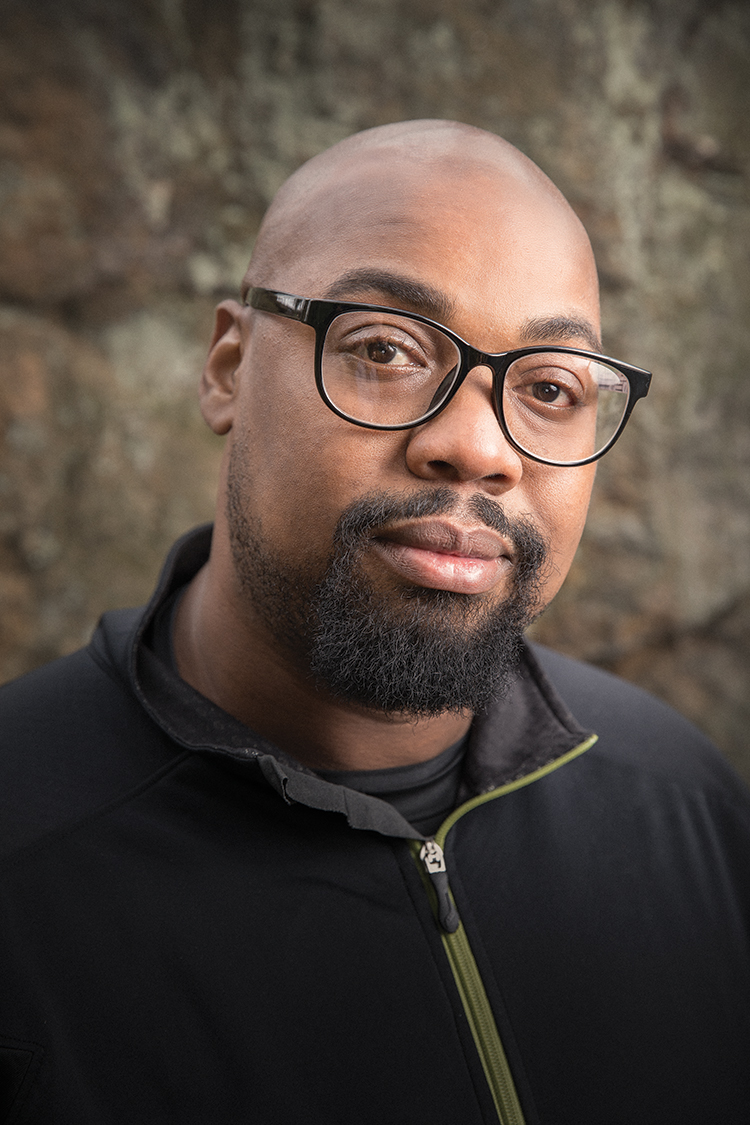“RUN YOUR OWN RACE,” a friend once told Gary Lambert, an adage he repeated over and over as searing pain shot through his hips and legs during a 100-mile bicycle race in April 2014. The probation officer from Philadelphia pushed to finish the event, but the discomfort persisted.
Lambert thought he had overtrained or overexerted himself or perhaps a disk had herniated. But after resting and months of physical therapy, the pain was worse. Six months after the race, the once-formidable athlete was walking with a cane. On Dec. 10, 2014, after a battery of tests and just a day shy of his 38th birthday, Lambert found out he had multiple myeloma, an uncommon and incurable form of blood cancer.
Bone pain is a common symptom of multiple myeloma, a disease that attacks white blood cells in bone marrow—the soft, spongy tissue at the center of bones. The rapid growth of cancer cells destroys the bone marrow, causing soft spots to form—especially inside the bones of the spine, pelvis and rib cage. These bone lesions are painful and can weaken the bone, often leading to fractures.
Read more about this type of cancer.
Taking Her Place
A profile of Geraldine Ferraro, the first woman nominated for vice president on a major-party ticket, who was diagnosed with multiple myeloma in 1998.
Treatment Is Waiting
Patients with certain blood cancers—including smoldering myeloma, which can progress to multiple myeloma—may be better off watching and waiting than actively pursuing treatment.
Vaccines: Looking Within for Cancer Treatment
Experimental vaccines that harness the body’s immune system offer up another treatment option for patients with cancers that are currently considered incurable, like multiple myeloma.
Making Adjustments
More than three years after Lambert’s multiple myeloma diagnosis, the race has changed for the husband and father of two. His large biceps belie his struggle with multiple myeloma, and he likes it that way. “I know the cancer is there. I know my limitations, but I don’t let the disease define me,” he says with a rebellious grin.

Gary Lambert Photo © Colin M. Lenton
An active 41-year-old, Lambert doesn’t completely fit the profile of a multiple myeloma patient. Nearly two-thirds of people diagnosed with the disease are at least 65 years old. Only 2 percent of multiple myeloma patients are under 40. Lambert’s race and ethnicity point toward an elevated risk, however: He’s Afro-Caribbean, born in Jamaica, and black men are more than twice as likely to get multiple myeloma as the general population.
His diagnosis came at a time when he was making strides to improve his health. In 2012, at age 35, Lambert decided to get fit and lose some weight. “Up until that point, I had lived a pretty sedentary lifestyle,” he says. Lambert weighed more than 350 pounds, and the excess weight was exacerbating his asthma. He started riding his bicycle to work. Then he began jogging. By early 2014, he had dropped 130 pounds. It was the healthiest he had ever felt.
In retrospect, he realizes the pain started to creep in before the 100-mile bike ride. There was hip and leg pain that never really subsided after he ran a half-marathon in March 2014, but he kept training. The pain soon spread to his lower back. In June, he started physical therapy, hoping to get relief. When the pain did not subside, Lambert’s doctor ordered an X-ray of his spine. “We thought he had injured himself, and we were looking at back surgery,” says Lambert’s wife, Nadia. “At the time, cancer was not on our radar in any way, shape or form.”
But the X-rays showed a more troublesome problem—soft spots in Lambert’s spine that are a telltale sign of multiple myeloma. An MRI, bone biopsies and an X-ray survey of his entire skeleton led to the diagnosis of stage III multiple myeloma. Cancer cells had overtaken 80 percent of his bone marrow.
“Emotionally, I think Gary just shut down for a little while,” says Nadia. “He’s always been more outwardly stoic about things. Of course, I was making puddles everywhere from copious weeping.”
In those first difficult hours, Lambert thought a lot about the future, and about his wife and two children, Ethan and Ava, then ages 6 and 5. He asked his doctor, “Well if there isn’t a cure, what can we do to extend my life?”
Thinking Like MacGyver
Although multiple myeloma isn’t curable, it is treatable. The day after his diagnosis, Lambert started chemotherapy at the Sidney Kimmel Cancer Center at Thomas Jefferson University in Philadelphia. Multiple myeloma patients who are candidates can be treated with a combination of high-dose chemotherapy to kill the cancer cells and a stem cell transplant to replace the bone marrow cells. A transplant doesn’t cure the cancer, but it can send multiple myeloma into partial remission for years at a time.

Gary Lambert rides his bicycle through Wissahickon Valley Park near his Philadelphia home. Lambert credits an active lifestyle with helping him handle setbacks. Photo © Colin M. Lenton
“In order to attack the cancer, I felt like I had to understand what was happening to my body and why we were doing certain things,” says Lambert. He was inspired by the TV character Angus MacGyver, who used inventiveness and any object at hand to deal with a difficult situation.
“Nothing stopped [MacGyver] from getting through problems and enjoying life. Once he got to work on a plan, he saw it through,” Lambert says. Lambert did his homework. He asked questions of every doctor he saw, read articles on multiple myeloma research and treatment, and got to know his disease inside and out.
Lambert’s strength and fitness allowed his doctors to take an aggressive approach to treatment. “They hit me hard, because I was young and strong,” he says. Hematologist and researcher Kanti Rai of Long Island Jewish Medical Center, New Hyde Park, and the Feinstein Institute for Medical Research, Manhasset, both in New York, says that’s probably true. “A physically fit patient, in general, will have more strength to fight the onslaught of chemo and its related side effects,” says Rai, who was not involved in treating Lambert.
For the first six months of treatment, Lambert received a three-drug cocktail known as RVD—Revlimid (lenalidomide), Velcade (bortezomib) and dexamethasone—to kill the cancer cells. Lambert experienced mood swings, weight gain, insomnia, nerve pain, temporary vision loss and even a life-threatening infection that sent him to the emergency room in septic shock.

Gary Lambert walks his dog, Kiba, in Wissahickon Valley Park. Photo © Colin M. Lenton
Then there were the painful bone marrow biopsies to measure whether the treatment was working. To get a sample, the doctors inserted a needle into Lambert’s hip bone to remove bone marrow. “I had to get into a mental state where I would just curl up and bear it,” he says.
Lambert missed several months of work. His co-workers banded together to donate 400 hours (roughly 2.5 months) of vacation time to help Lambert minimize the unpaid leave he’d have to take. The gesture was a huge help in easing the financial stress, he says.
The next step in his treatment was the stem cell transplant that would help restore the bone marrow’s ability to make normal blood-producing cells. As doctors prepared him for the transplant, however, Lambert got bad news. He had cardiomyopathy, an abnormality in his heart muscle that is an uncommon side effect of chemotherapy. It meant his heart wasn’t strong enough to withstand the stem cell transplant—he’d have to wait several months for his heart to recover before undergoing the procedure. “That right there was the cherry on the sundae,” jokes Nadia.
By October 2015, Lambert’s heart was strong enough for the transplant. In a specially sealed, germ-free room meant to protect patients with weakened immune systems, doctors fed Lambert stem cells through an IV line inserted into a vein in his chest. The transplant was autologous, meaning Lambert received a transfusion of his own stem cells that had been harvested from his bloodstream earlier in treatment.
The procedure was a success. Lambert’s doctors determined that he had achieved partial remission, meaning just a small number of myeloma cells remained. After two weeks in the hospital, he went home.
Focused on Living
After the transplant, Lambert remained on a low daily maintenance dose of Revlimid to keep the myeloma cells from multiplying. He faced a long road back to fitness. His body had changed since treatment. He no longer had the energy for long runs and bike rides. His muscles were weak and he had peripheral neuropathy, a condition caused by chemotherapy in which the nerves in his extremities were damaged.
Lambert started exercising again two months after the transplant. He began lifting weights four days a week, starting with lighter weights and progressing to heavier loads. He found a new fitness love—Brazilian jiujitsu, a martial art and contact sport. His doctors discouraged his participation because multiple myeloma survivors can have weak bones, but Lambert wanted to be the judge of what his body could withstand. He says the mental discipline he learned through martial arts has helped him overcome fear and grapple with his own mortality.

The Lamberts work together on a baking project in their Philadelphia home. From left are Nadia, Ethan, Ava and Gary. Photo © Colin M. Lenton
Lambert doesn’t talk much about multiple myeloma in the gym or the martial arts studio. Most people he works out with don’t even know he has the disease. He wants to live his life like he doesn’t have cancer—to get physical and not think about the stress of doctors’ appointments and treatments. “Myeloma is a weird disease in that you’re living with it. It’s never gone. It always comes back. Pushing my physical limits helps me get out of my own head,” he says.
Yet Lambert says he takes a practical approach and listens to his body. “I do what I enjoy, but I’m not reckless,” he says. Some days are harder than others. “I never know how I’m going to feel tomorrow. Sometimes pushing myself will do more harm than good, so I’ll take the day and get some rest.”
In April 2016, Gary, Nadia and their two children moved from an apartment in South Philadelphia to a home in Mount Airy—a quiet neighborhood in the city’s northwest section. There, the family can live in more natural surroundings while still residing in Philadelphia—a requirement for city employees. He enjoys walking with his family on the nature trails at nearby Wissahickon Valley Park.
Treatment Advances
Even in patients who achieve remission after a stem cell transplant, myeloma cells can still be found in the blood. Over time, those cells can grow and multiply if not treated effectively. Yet medical advances in the past decade have dramatically changed the spectrum of treatment options available for advanced multiple myeloma. According to Rai, the outlook for patients is getting brighter. “Before, we didn’t have much to offer people when the disease returned,” says Rai. “New medications have now changed the entire spectrum of treatment for relapsed or refractory multiple myeloma.”
New drugs—called immunomodulators because they alter the immune system’s response to cancer cells—have increased life expectancy for some multiple myeloma patients by helping to keep the disease in remission longer. Revlimid—the drug Lambert took for treatment and as maintenance therapy—is an immunomodulator. It also works by cutting off the blood supply that myeloma cells need to grow.
Experimental treatments, including CAR-T cell therapy—which uses a patient’s own modified immune cells to treat cancer—are showing promise in early clinical trials, says Rai. (See “A New Multiple Myeloma Treatment on the Horizon” below.) “The progress in the last seven to 10 years has been extraordinary. With new treatments likely to surface in the next couple of years, people with multiple myeloma have good reason to hope and remain optimistic,” he says.
Early studies show some promise for CAR-T cell therapy.
In CAR-T cell therapy, immune cells called T cells are taken from a patient’s blood and genetically modified in a laboratory to attack cancer cells. The modified T cells are then infused back into the patient’s body. Many multiple myeloma patients participating in two early-phase clinical trials presented at the American Society of Clinical Oncology annual meeting in June 2017 achieved complete remission after CAR-T cell therapy, meaning there was no trace of cancer cells after treatment. Doctors don’t yet know how long the remissions will last in these patients and whether the therapy can be considered a cure.
A New Development
In October 2017, Lambert got some bad news—the myeloma cells were growing again. He started a new drug regimen that includes a different immunomodulatory drug—Darzalex (daratumumab)—which was approved in 2015 for use in patients with multiple myeloma that doesn’t respond to or becomes resistant to standard treatments. The new drug helped to bring his myeloma cell levels back down.
The news hit him hard. “As much as you prepare for things, when it happens, it can throw you off guard,” says Lambert. He is exploring clinical trials for CAR-T cell therapy.
“My doctor and I think it will give me the best shot at long-term remission,” says Lambert. Yet applying for a clinical trial is a bit like applying for college, he says. “Trials have strict criteria for candidates they think will really test the effectiveness of the drug.”
His backup plan? Another stem cell transplant—this time using donor bone marrow cells instead of his own.
Either option is sure to be physically draining. To keep his body strong, he continues to exercise several times a week—hiking nature trails, riding his bike or practicing martial arts.
“It’s obvious to anyone who knows Gary that he wants to be as healthy as possible for his wife and kids,” says co-worker Michael Gagliardi. “Despite all he’s been through, he stays positive. He just puts his head down and works. You have to respect a guy like that.”
Yet Lambert admits that staying positive isn’t always easy. “There are days when I just feel really, really sick and tired, and it’s a struggle mentally to get out of bed,” he says. “But somehow, I manage. I keep going.”
His goal isn’t to inspire. “I just want to be with my family. I want my kids to know their dad is going to be there for them.”
Cancer Today magazine is free to cancer patients, survivors and caregivers who live in the U.S. Subscribe here to receive four issues per year.





